Eye vision
In general it’s been said that the vision of fishes is not too clear. And that there’s a lot of reaction on shadow effect. But is that really the case?
A large group of fish are somewhat limited in their field of vision because water reduces both the brightness and the contrast of objects. In short, an object can be seen by a fish if both the brightness and the contrast can be clearly distinguished from the background. Since air and water are differently related in terms of brightness and contrast reproduction, the most important for vision is how intensively the light is reflected and the contrast determined by the difference between the object to be perceived and its background. In water these two factors are much more variable than in air. Light is simply absorbed in water. The deeper the transmission of light has to go, the more light absorption takes place.


The field of vision or visual field (= this is the image that can be viewed without moving the head or eyes) is a significant sensory system for all animal life forms except for blind animals. This also applies for all sighted fish (there are blind fish such as the blind cave fish). Of course, there are also animals that perceive things better through echo location. Fish eyes are almost similar to those of terrestrial vertebrates as we know them from mammals and birds. The main difference here is that the lens in the fish is more spherical compared to that of mammals and birds. Mammals and birds normally adjust their focus by changing the shape of the lens. Fish on the other hand, adjust their focus by moving the lens closer or further from the retina through attached muscles (retractors or protractors depending on the type of fish involved). In addition of a different lens shape, fish also lack eyelids and tear glands. A large group of fish species have a larger monocular (vision using two eyes that are separately located on each side of the head) vison field compared to humans. But humans on the other hand, have a better binocular vision field (the same object can be observed simultaneously through the placement of the eyes at the front of the head (see the illustration below).
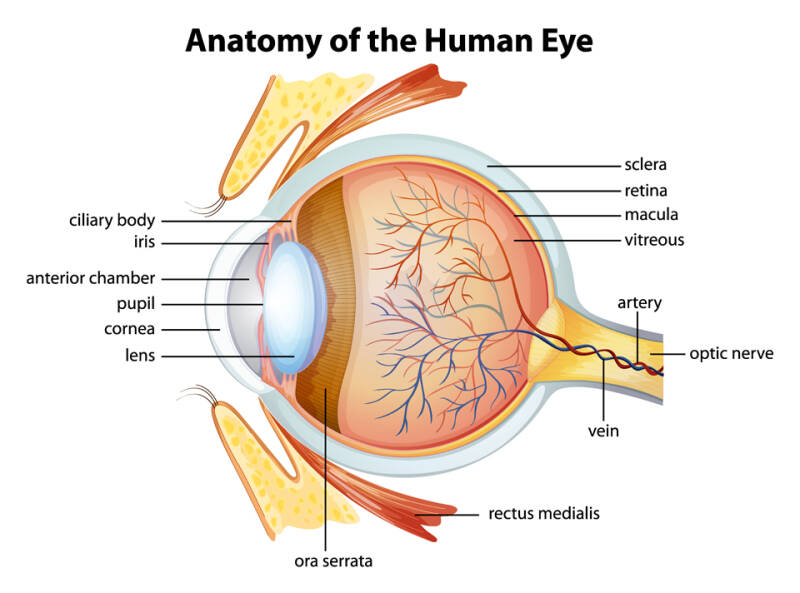


Fish retinas generally have both cone and rod cells to provide photopic and scotopic vison. The majority of fish have also color vision. And the remaining sighted fish species only have black and white vison. There are also fish that can perceive ultraviolet and some are sensitive to polarized light (anchovy is a good example of this).
The aforementioned cone cells are light-sensitive cells in the retina and work best in relatively bright light (photopic). The pupil is wide and the colors can be perceived better. This is accompanied by a better vision field and sharpness. Most fish have double cones (two cones cells joined together). Each part of a double cone can have a different peak absorption. Fish behavior has shown that each type of an individual cone within a double cone can provide its own information package for visualization.
Rod cells on the other hand, work best in lesser light (scotopic). The pupil is constricted and open and colors can be perceived less well or not even. This is accompanied by a poor field of vision and sharpness
Photopic, scotopic and mesopic vision are terms from ophthalmology and sensory physiology.
* Photopic vision refers to viewing in good lighting. The eye pupil is narrow, and the maximum light sensitivity of the retina is at a wavelength of 555 nm (green). Colors can be observed well.
* Scotopic vision refers to seeing in low light. The eye pupil is wide, and the maximum light sensitivity of the retina is at a wavelength of 505 nm (blue-green). Colors are hardly or not at all perceived.
* Mesopic vision is defined as the transition area between photopic and scotopic vision.
These terms come from Ancient Greek, from respectively φῶς (phōs,light), σκότος (skotos,darkness) and μέσος (mesos, middle).

Thus a variety of the degree of vision of fish can be discerned. Fish can therefore have a poor field of vision, but there are also fish with a very good field of vision. For instance, look at deep see fish. For such fish are less vulnerable to sighted predators and it’s even an advantage to have a convex eye lens. Such a convex eye lens collects much more light than a concave and a flat eye lens. A fish’s field of vision is subject to an evolutionairy adaption of their visual environment. Deep sea fish are a good example of this. They can orient themselves very well in a dark environment.
A fish’s visual vision is mediated by four visual pigments that absorb light of multiple wavelengths. Each of these pigments consists of a chromophore (color cell) and the transmembrane protein. This transmembrane protein is called “Ospin”. Mutations that originated in the ospin have resulted in a visual diversity, including the variation of in the wavelength absorption. The mutations in the ospin allow a large group of fish species to absorb UV light. The UV light vision they have works as an advantage in foraging, communication and the making of a partner choice. So, it seems that throughout the evolution, it is better developed in one species than in another.

Looking at viviparous tooth carps… the Anableps anableps makes a good example. In English, this fish, which occurs in both brackish and freshwater, is called “Four eyed fish”. They are very typical recognizable by the large eyes on top of the head that usually let them protrude above the surface of the water. In that respect they do look a bit like mudskippers.

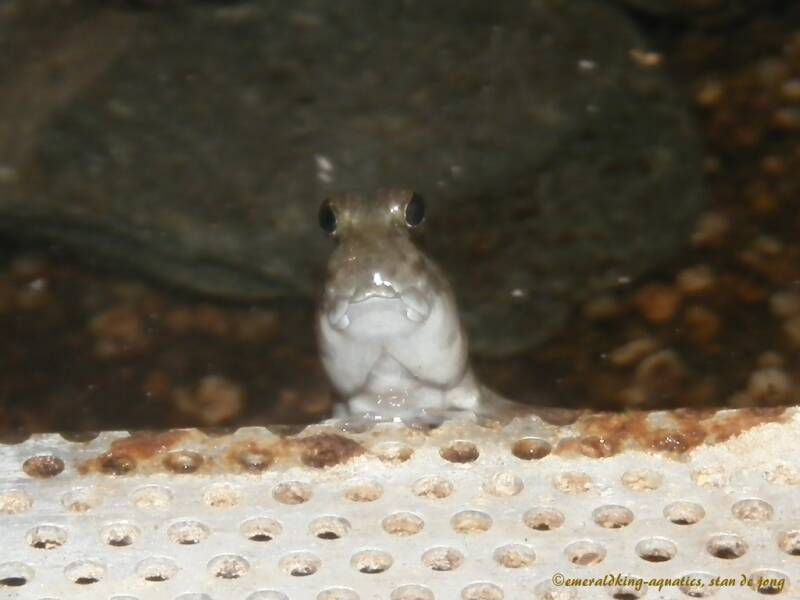
Despite of the name “Four eyed fish”, it’s actually not a fish with four eyes. But each eye of the Four eyed fish consists of two parts. An upper and a lower part, to be precise. Each eye has a seperate pupil that can respond separately from eachother. This gives them simultaneous visibility above the water surface and below the water surface. Definitely a good strategy with regard to possible predators. They are also
popular snacks to certain birds. In the event of a visual threat, they can therefore quickly swim away to escape from their predators.


Changing eye color in guppies
Another interesting story is the discoloration of the eyes in guppies from Trinidad. It’s known that the eyes of certain guppies from Trinidad can change color. Where the iris is normally silvery colored, it can turn from silver to black during excitement or aggression. This suddenly makes the eyes appear larger and would have a deterrent effect on other fish.
Below: Courtesy by Current Biology.
The four part matador strategy.

Above & below:
The change of eye color in Trinidad guppies is also used to get predators distracted and to escape from them.
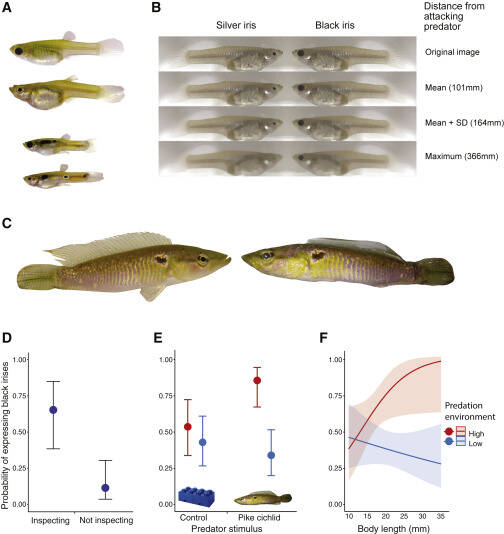
This ability is also used as a deterrent mechanism by these types of guppies. In this case we can even speak of a form of communication, as can also be the case with other types of animals. For in the animal kingdom, communication with the eyes is also used. Consider for instance birds, arthropods, etc. As far as the case with the Trinidian guppies is concerned, this has been researched by the University of Exeter in collaboration with the University of the West Indies. In which Dr. Robert Heathcote (leader author of this study) confirms its substantiation that the iris color of these guppies can actually change within seconds. Aggression, preventive protection and dominance towards other guppies or other fish play a significant role in this.
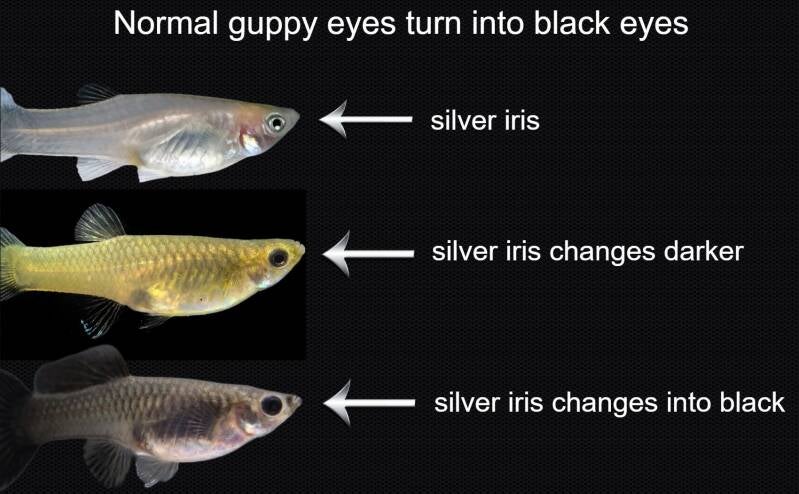
As already been mentioned this change of eye color only refers to wild guppies from Trinidad. But this also happens in breeding forms of guppies. In that case, those breeding forms must have genes from wild populations of wild guppies from Trinidad. For other wild populations of wild guppies found elsewhere on this globe don't have the ability to change eye color.
There are also fish that are born with total black eyes. That's something different. They have a high density of melanophores in the iris. This does happen in mollies, platies and guppies for instance.
Albinism
Albinism (RREA) in the eyes is the lack of melanin in the eyes. The iris of the eye gets a red glow due to the lack or the strong deficiency of the melanin. The red eyes in the albinos are also more sensitive to light. Visibility is also less compared to black eyed fish. This applies to all ocular (only albinism in the eyes) and oculocutaneous (albinism in the eyes and the skin) albino fish.
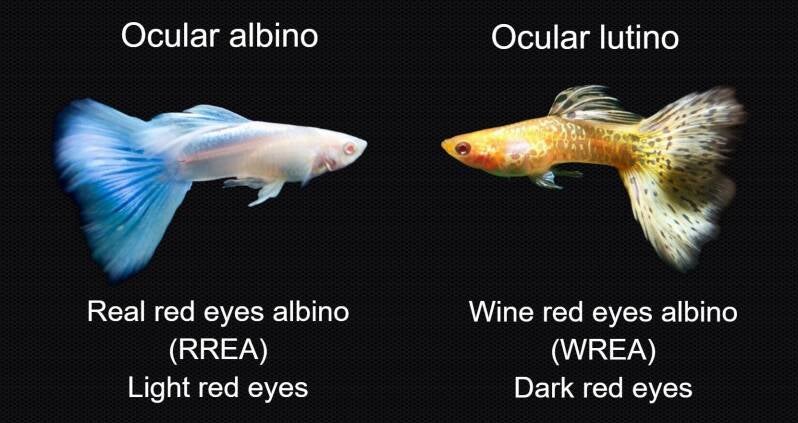
Another type of ocular albinism is called "lutino" instead of "Albino'. The difference between lutino and albino is that in lutino fish, there is still some melanin present which makes the eyes look dark wine red also known as "WREA" which stands for " wine red eye albino. But also lutino fish are sensitive to light.
Therefore, it differs per fish species wether the visibility can be described as being good, average or as bad. What a fish can actually see is largely determined by the optical properties of the water.

